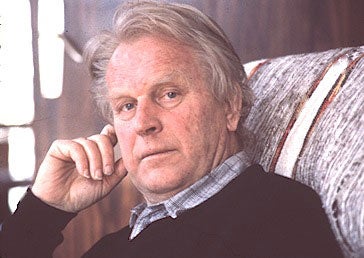Sverre Fehn: Architect whose work drew on local cultures

The Norwegian architect Sverre Fehn could be described as an "architect's architect". He was widely acknowledged both by his peers and contemporaries as the leading post-war practitioner in Norway. Seen as a Modernist, he developed an aesthetic that recognised national and local cultures, traditional materials and types of construction and precise forms.
Fehn was a reserved, sensitive, calm and immensely talented designer whose contribution to Norwegian architecture was only widely recognised outside the country after he had received the prestigious Pritzker Prize in 1997. After that, his small practice that had begun in 1954 gained a new lease of life. In all, however, he only built around 12 or so buildings; a number of his projects remained unrealised.
Scandinavian architecture in the Sixties had largely fallen out of favour with the British; architectural societies and earnest British students were more often directed to the US, where there was much more interest in the International style propounded by Le Corbusier and the more rational approach of the German architect Ludwig Mies van der Rohe, who was working in Illinois. Fehn graduated in 1948 from the Oslo School of Architecture where he later worked for two decades as Professor of Architecture from 1971-91, alongside important theoreticians such as Christian Norberg-Schulz and his student Thomas Thiis-Evensen.
After finishing his studies in Oslo he travelled to Morocco, before spending a year or so (1952-53) in Paris where he worked for Jean Prouvé and met Le Corbusier. He acquired important technical knowledge from these contacts, although it seems unlikely that this caused him to alter his view on an architecture which was more in tune with Frank Lloyd Wright's organic ideas and his own local vernacular traditions than the modern functionalism. Indeed, it is said that Fehn referred to architecture as a "bully" of nature: "I strive to make a building that will make people more aware of the beauty of the setting," he wrote.
Fehn had been taught by the modernist architect Arne Korsmo, and with his mentor and friend and seven young architects he was a founding member of PAGON (Progressive Architects' Group Oslo Norway), which was established in 1951 to promote the idea of a national modern architecture.
Fehn was the most talented of the members: his Handicraft Museum at Lillehammer, some 115 miles north of Oslo, demonstrated a new architectural language characterised by his use of materials and clarity of form.
"[It is] one of the wonderful Scandinavian open air museums, a folk art and architecture," noted the architecture writer George Kidder Smith in 1961. "The positive forthrightness of the new building and its raw concrete expression reflect the structural directness of the vernacular wood buildings about it."
With the architect Geir Grung he also designed a number of low and handsome buildings, including the Økern's Old Peoples home in Oslo with its beautifully scaled courtyards.
Despite his successes, Fehn was somewhat isolated from the mainstream of modernism, but he received wider recognition when he won the competition for the design of the Norwegian Pavilion at the 1958 Brussels World's Fair. In the same year he also won the competition for the Nordic Pavilion for the Venice Biennale, which was completed for the 1962 exhibition.
Another major highlight of his career was his work at the Headmark Museum in Hamar, Norway (1967-79), where he built huge protective structures to safeguard medieval ruins and artefacts. It was an exceptional challenge which Fehn rose to magnificently. "The new structures establish new volumes within the old ones which give the objects new life," Fehn himself noted. "The design expresses some of the free movement between heaven and earth." It is a consummate work of artistic synthesis of architecture, curatorship and display design.
Good and original domestic work followed in Norway and in Sweden. In 1991 he completed the more widely known Norwegian Glacier Museum in Fjaerland and in 2001 the Ivar Aasen Centre in Oersta and the Norwegian Museum for Photography – another uniquely planned conversion.
In a last flurry of activity the Norwegian Museum of Architecture was completed in 2007 with a retrospective exhibition of Fehn's work. He also designed the Oslo headquarters of the Gyldendal Publishing House at the very end of his professional career.
Fehn's highest international honour came in 1997, when he was awarded both the Pritzker Architecture Prize and the Heinrich Tessenow Gold Medal. He was also made an honorary fellow of Norwegian, Finnish, Scottish, British and American architecture associations and institutes, as well as of the royal academies of Copenhagen and Sweden. In 1993 he received the Gold Medal from the French Academy of Architecture and in 2001 he became the first recipient of the Grosch medal, an award established to commemorate the works of Norway's seminal architects from the era of nation-building.
Dennis Sharp
Professor Sverre Fehn, architect and teacher: born Kongsberg, Norway 14 August 1924; married 1952 Ingrid Loberg Pettersen (died 2005; one son); died Oslo, Norway 23 February 2009.
Subscribe to Independent Premium to bookmark this article
Want to bookmark your favourite articles and stories to read or reference later? Start your Independent Premium subscription today.

Join our commenting forum
Join thought-provoking conversations, follow other Independent readers and see their replies